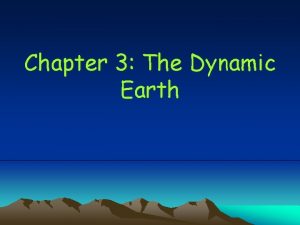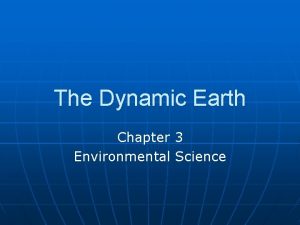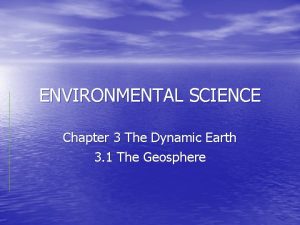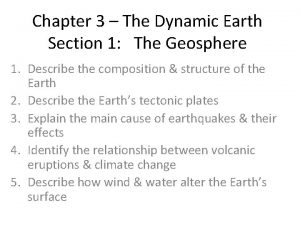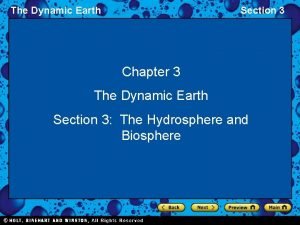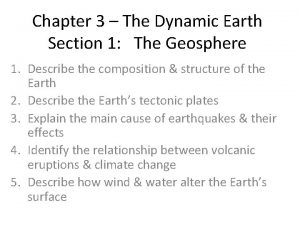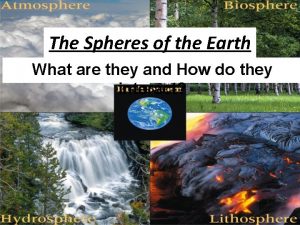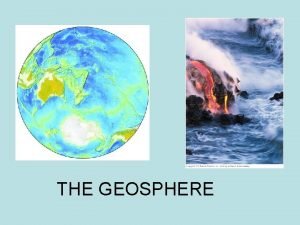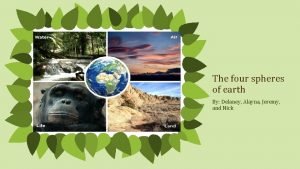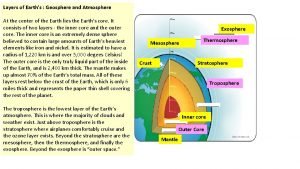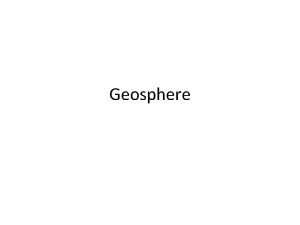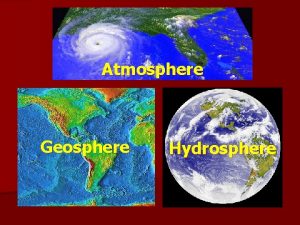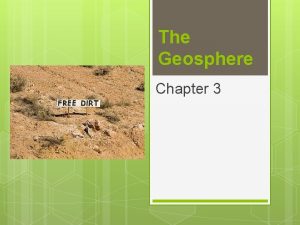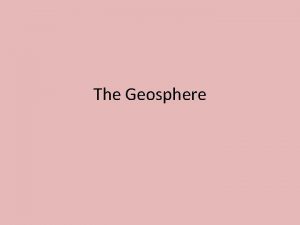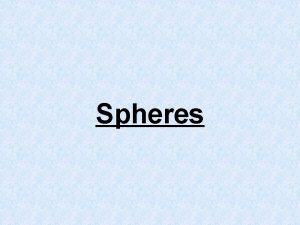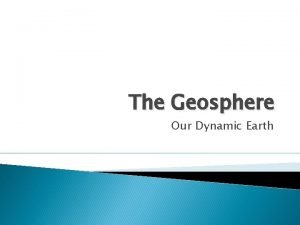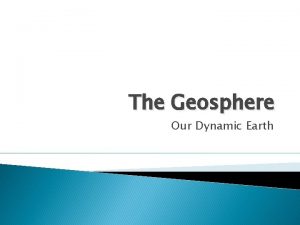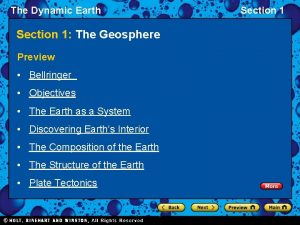The Dynamic Earth Geosphere Chapter 3 1 Earth










- Slides: 10

The Dynamic Earth Geosphere Chapter 3 -1

Earth as a System �The Earth is divided into four parts that all interact with each other �Geosphere (rock) � Diameter of the Earth = 12, 756 km � Consists of solid rock, loose rock and soil as well as the interior �Atmosphere (air) �Hydrosphere (water) �Biosphere (living things)

The Earth’s Interior �Scientists have used seismic waves to determine the interior composition of the Earth �The waves are produced during earthquakes �As the wave travels through different materials, it changes speed and amplitude �Earth is divided into four layers �Crust – less than 1% of Earth’s mass, between 5 and 70 km thick �Mantle – 64% of Earth’s mass, apx. 2, 900 km thick, molten rock �Outer Core – 2, 200 km thick, liquid nickel and iron �Inner Core – 1, 228 km radius, solid nickel and iron

Seismic Waves

Physical Layers

Earth’s Layers: Physical Properties �If the physical properties are consider instead of the chemical, the Earth may be divided into five layers �Lithosphere – outer most layer, includes crust and uppermost part of the mantle �Divided into tectonic plates � 15 – 300 km thick �Asthenosphere – plastic, solid layer of the mantle �Made of liquid rock that moves very slowly and allows the plates to move on top of it � 250 km thick �Mesosphere – “middle sphere” is the lower part of the mantle � 2, 550 km thick �Outer Core – Same as previous description �Inner Core – Same as previous description, temperature is between 4, 000 and 5, 000 degrees C

Plate Tectonics The lithosphere is divided into Tectonic Plates These can move around much like ice floats drift across a pond The continents are located on the plates and float with them When the plate edges interact, they can create dramatic forces through collisions, division and sliding When the plates move, it causes rocks on the earths crust to buckle and break. The may cause the formation of mountains and volcanoes

Plate Tectonics �When plates move against each other, various interactions may occur �Subduction: When one plate slide under another, plunging into the mantel � Volcanoes may result from this �Collision: May result in two plates crumpling upward as they push into each other � Ex: Himalaya Mountains �Transform faults: Two plates rub in opposite directions causing earthquakes. � Ex: San Andreas Fault �Hot spots are responsible for hot springs, geysers and island chains

Earthquakes and volcanoes Earthquakes occur when the plates slide along a fault (a break in the Earth’s crust) Vibrations created from the sliding result in earthquakes of various magnitudes (strengths) Magnitude is measured on the Richter scale on a range from 0 to 10. The largest magnitude ever recorded was a 9. 5 Widespread damage is cause from earthquakes 7+ Volcanoes are mountains built from magma (melted rock) These occur under the sea or on land Most volcanoes are found on the boundaries of the pacific plate Eruptions occur when pressure builds up and blows open the solid surface of the volcano Clouds of hot ash and gas can travel up to 200 km/hr and cause sever damage, they can also create climate shifts

Erosion On the surface of the Earth, rocks are change but forces other than just plate movement “Removal and transport of surface material is called erosion” Water Erosion – erosion by rivers and oceans Coastlines may be changed to create cliffs and rivers can carve deep canyons and gorgers EX: White Cliffs of Dover and the Grand Canyon Wine Erosion – Wind can blow soil away in places where there are few plants to hold it down Over time, the wind may wear down large rocks, such as sandstone in the desert, to create huge formations
